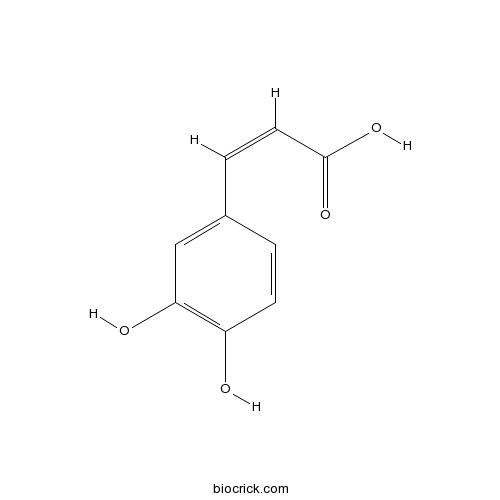Pyrus pashia
Pyrus pashia
1. The products in our compound library are selected from thousands of unique natural products; 2. It has the characteristics of diverse structure, diverse sources and wide coverage of activities; 3. Provide information on the activity of products from major journals, patents and research reports around the world, providing theoretical direction and research basis for further research and screening; 4. Free combination according to the type, source, target and disease of natural product; 5. The compound powder is placed in a covered tube and then discharged into a 10 x 10 cryostat; 6. Transport in ice pack or dry ice pack. Please store it at -20 °C as soon as possible after receiving the product, and use it as soon as possible after opening.
Natural products/compounds from Pyrus pashia
- Cat.No. Product Name CAS Number COA
-
BCN5979
Caffeic acid331-39-5
Instructions

-
BCN5788
Cosmosiin578-74-5
Instructions

Chrysin isolated from Pyrus pashia fruit ameliorates convulsions in experimental animals.[Pubmed: 29284373]
The traditional use of the ethanolic extract of the fruit of Pyrus pashia (EPP) as a potential anticonvulsant was validated using experimental animal models. Furthermore, the anticonvulsant activity of isolated chrysin was investigated against experimental animal models to draw a possible therapeutic mechanism of EPP. Additionally, the safety profile of chrysin was evaluated to explore the possible therapeutic alternative in the management of epilepsy.
Pyrus pashia: A persuasive source of natural antioxidants.[Pubmed: 26408875]
Pyrus pashia Buch. & Ham. was subjected to extraction with methanol. Methanolic extracts of fruit, bark and leaf were partitioned separately with four organic solvents in order of increasing polarity, asn-hexane, chloroform, ethyl acetate and n-butanol after dissolving in distilled water. Phytochemical screening revealed the presence of phenolics, flavonoides, alkaloids and cardiac glycosides in large amount in chloroform, ethyl acetate and n-butanol soluble fractions. The antioxidant activity of crude methanolic extracts, all the obtained fourorganic fractions and remaining aqueous fractions was evaluated by different methods such as: 1,1-diphenyl-2-picrylhydrazyl (DPPH) free radical scavenging activity, ferric reducing antioxidant power (FRAP) assay and total antioxidant activity by phosphomolybdenum complex method as well as determination of total phenolics. The results of antioxidant activity exhibited that chloroform soluble fraction of fruit showed the highest value of percent inhibition of DPPH (48.16 ± 0.21 μg/ml) at the concentration of 10 μg/ml. Ethyl acetate soluble fraction displayed the lowest antioxidant activity having IC50 value of bark as (8.64 ± 0.32 μg/ml) relative to butylated hydroxytoluene (BHT), having IC50 of 12.1 ± 0.92 μg/ml. The ethyl acetate soluble fraction of bark revealed the highest FRAPs value (174.618 ± 0.11TE µM/ml) among all the three parts. This fraction also showed the highest value of total antioxidant activity as (1.499 ± 0.90), determined by phosphomolybdenum complex method. Moreover, this fraction also conferred the highest phenolic content (393.19 ± 0.72) as compared to other studied fractions of fruit and leaf.
A new phenolic compound with antioxidant activity from the branches and leaves of Pyrus pashia.[Pubmed: 26119567]
The branches and leaves of Pyrus pashia are used to cure abdominal pain and diarrhoea in Chinese folk medicine. A new phenilic compound, 4-O-β-d-glucopyranosylbenzyl-benzoate ester (1), along with 21 known ones (2-22) were isolated from the branches and leaves of this plant. Compounds 2 and 3 displayed remarkable antioxidant activities against 1,1-diphenyl-2-picrylhydrazyl radical (IC50 = 13.26 ± 0.04 μM, 13.28 ± 0.11 μM, respectively), which were at the same grade as positive control rutin. The caffeoyl group in compounds 2 and 3 was supposed to play an important role in the antioxidant activities.
Scientific basis for use of Pyrus pashia Buch.-Ham. ex D. Don. fruit in gastrointestinal, respiratory and cardiovascular ailments.[Pubmed: 25786248]
Pyrus pashia Buch.-Ham. ex D. Don. has been used conventionally by many communities in the Himalayan region for the management of gastrointestinal, respiratory, and vascular complications. Set against this background, this study was carried out to justify the scientific basis to validate folkloric uses of fruits of Pyrus pashia Buch.-Ham. ex D. Don. (Pp.Cr) in traditional systems of medicine.


